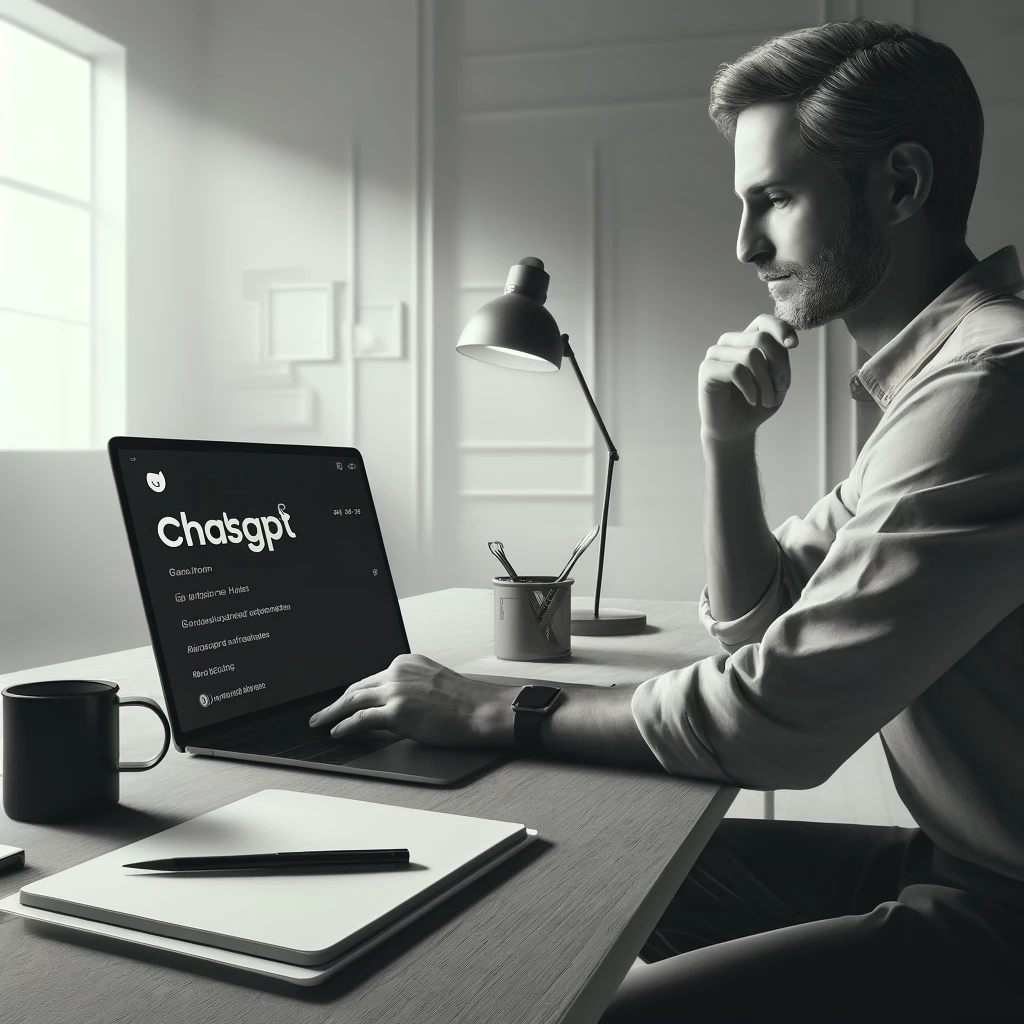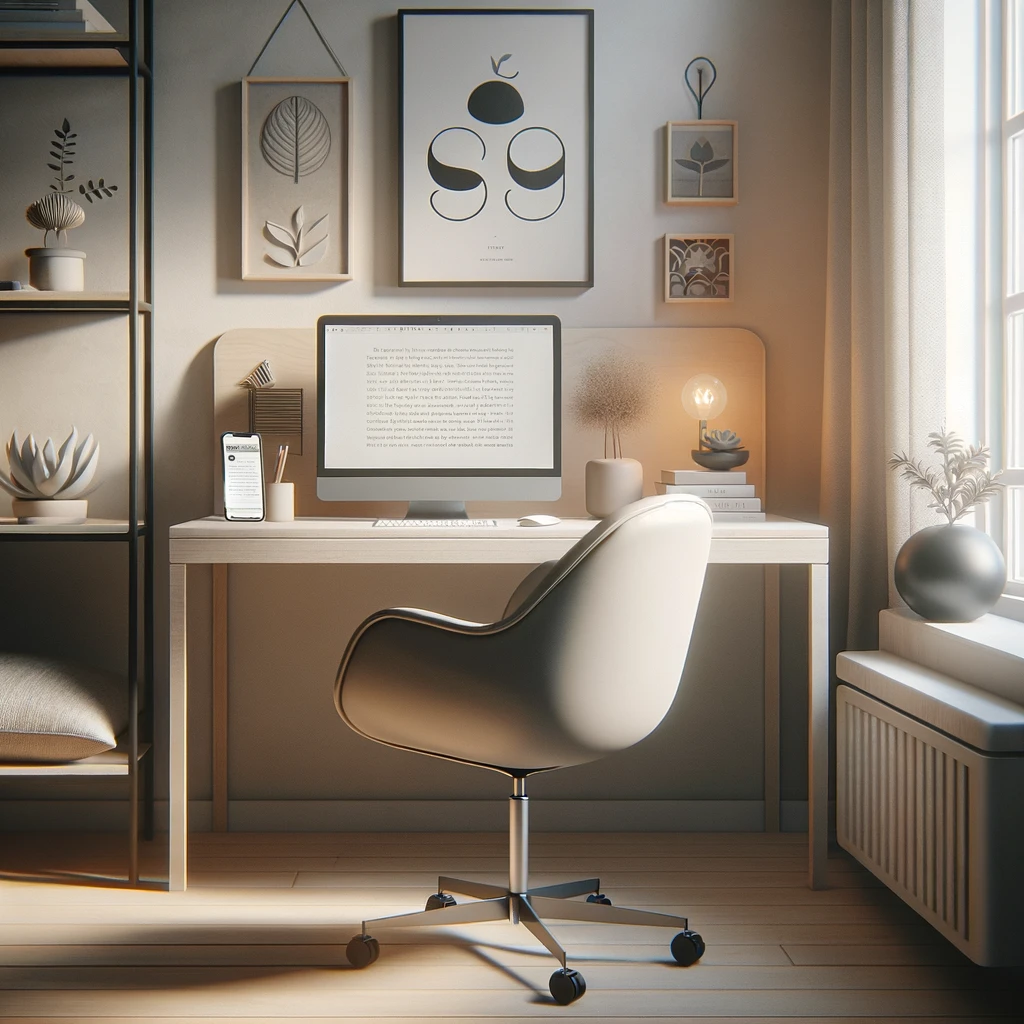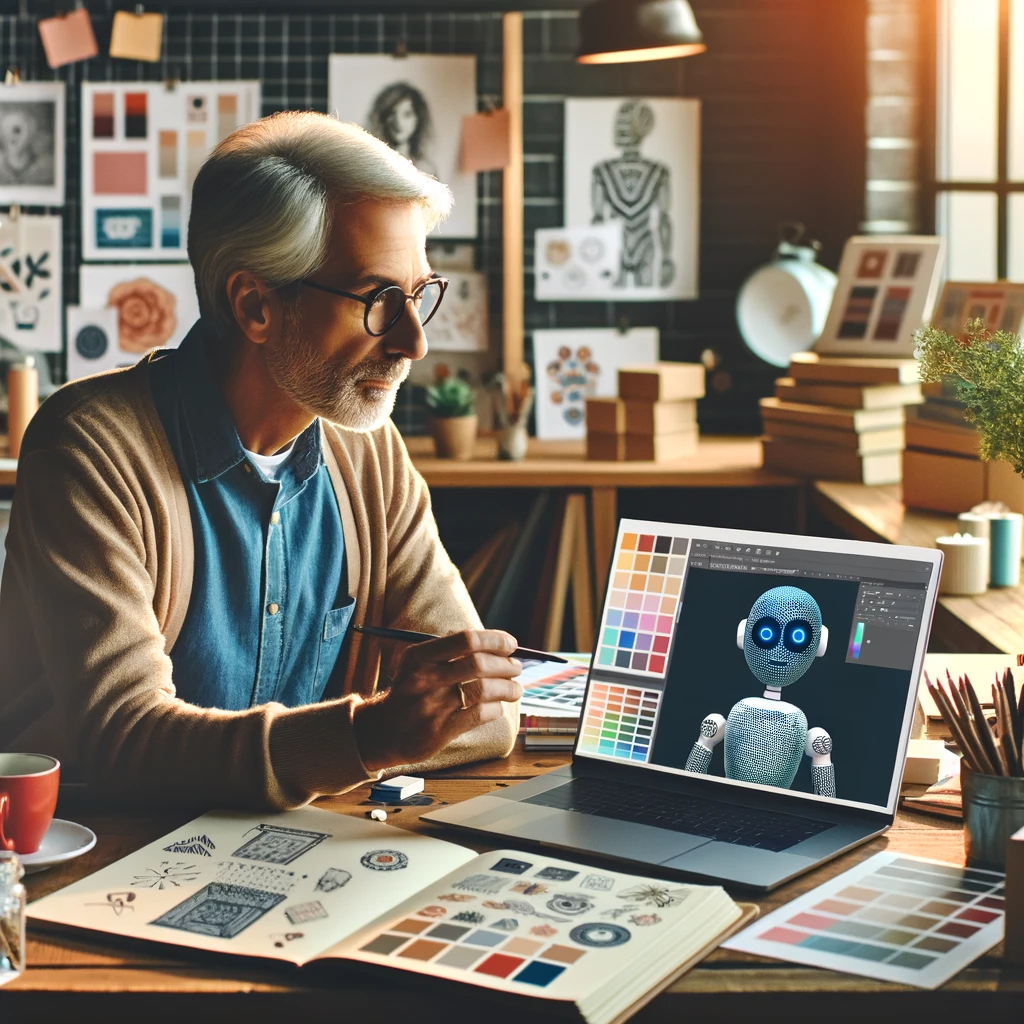The rise of artificial intelligence (AI) is reshaping many industries, and the creative sectors are no exception. From filmmakers who use AI to edit scenes to graphic designers who integrate AI tools to enhance visual content, the impact is evident and growing. AI is not just about efficiency; it’s also about opening up new ways to create and innovate.
At the forefront of this revolution is ChatGPT, a tool developed by OpenAI. ChatGPT is an advanced AI that specializes in understanding and generating text that sounds like it could have been written by a human. This capability makes it incredibly useful for a range of tasks, from writing and customer service to brainstorming and problem-solving.
In this blog post, we’ll dive into how designers can use ChatGPT to boost their visibility and marketing efforts. Whether you’re looking to streamline your creative process, enhance your social media presence, or engage more effectively with clients, ChatGPT offers a plethora of tools to make your work stand out in the digital crowd. Let’s explore how you can harness this technology to elevate your design work and captivate a broader audience.
Understanding ChatGPT and Its Capabilities
So, what exactly is ChatGPT? Think of it as a really smart chatbot that’s been trained to understand and generate text that sounds human. It’s powered by something called generative AI, which basically means it can come up with (or “generate”) all sorts of responses based on the information it has learned. It does this using a technique known as natural language processing, or NLP, which helps it understand and use human language in a way that is meaningful.
ChatGPT has come a long way since its first version. Initially, it was good at answering questions and holding a basic conversation. But now, it has evolved to handle more complex dialogues and generate detailed text based on a wide range of prompts. This evolution has expanded its toolbox, making it an even more valuable asset for creative professionals.
Now, you might be wondering how ChatGPT can specifically help you as a designer. Here’s how:
Text Generation for Creative Content: Whether you need catchy taglines, compelling product descriptions, or engaging social media posts, ChatGPT can help you craft text that captures attention. It’s like having a brainstorming buddy who’s always ready to throw ideas around.
Interaction with Clients and Potential Customers: Imagine automating the initial interactions with clients who visit your website or engage with you via social media. ChatGPT can handle these conversations, responding intelligently to inquiries, which allows you to focus on the creative side of things.
Assistance in Brainstorming and Generating Creative Ideas: Stuck on a project? Need a fresh perspective? ChatGPT can be your go-to for a creative boost. By discussing your ideas with it, you can develop new angles on existing projects or spark inspiration for entirely new ones.
In short, ChatGPT is more than just a tool for automating tasks; it’s a versatile partner that can enhance your creative process and help you connect more effectively with your audience. As we delve deeper into how to use this tool, remember that the goal is to complement your skills and expand your creative possibilities, not replace the unique touch you bring to your work.
ChatGPT as a Tool for Content Creation
Creating content can be time-consuming, whether it’s for your website, social media, or promotional materials. But here’s where ChatGPT can really shine and lend a hand. Let’s break down how this tool can help you craft content that not only looks good but also connects and converts.
Writing Compelling Descriptions
Every designer knows that a well-written description can elevate a product from good to must-have. ChatGPT can help you craft these persuasive product descriptions and promotional content quickly. Start by feeding it the key features of your product and the emotion or theme you want to convey. ChatGPT can then generate several options for you to choose from or refine. This can be a real game-changer, especially when you’re trying to balance multiple projects and need to get marketing content out the door.
Example: Imagine you’ve designed a minimalist chair. Tell ChatGPT something like, “Create a product description for a minimalist chair designed for small spaces, focusing on its sleek design and comfort.” You’ll get a variety of descriptions, and you can pick the one that best fits your vision or sparks an idea for further refinement.
Blogging and Article Writing
Keeping a blog or writing articles can boost your visibility and establish you as a thought leader in the design world. However, staring at a blank page can be daunting. ChatGPT can help jump-start your writing process. Give it a topic, such as the latest design trends or tips on sustainable interiors, and it will draft a post for you. From there, you can add your personal touch and insights to make the voice true to your brand.
Steps for Refining AI-Generated Text:
- Review the draft to ensure it aligns with your factual understanding and professional opinions.
- Add personal anecdotes or client stories to make the article more relatable.
- Adjust the tone to match how you naturally speak or write, ensuring it resonates with your audience.
Social Media Content
In today’s digital age, a vibrant social media presence is key to engaging with your community and attracting new clients. ChatGPT can help you create catchy posts that capture the essence of your work and the attention of your followers. Tell it about the project you want to showcase, the style of the post, and any key messages, and it will provide you with content that you can fine-tune.
Strategies for Consistency:
- Use ChatGPT to plan and prepare a batch of posts at once. This helps maintain a consistent posting schedule without daily pressure.
- Experiment with different prompts to see what generates the most engagement, and refine your approach based on what works.
With these tools and strategies, ChatGPT can significantly reduce the time you spend on content creation, giving you more time to design and less time stressing about what to post or write next. In the next section, we’ll explore how ChatGPT can also enhance your interactions with clients and streamline your customer service, making your whole workflow more efficient.
Enhancing Client Interaction and Networking
In the world of design, making a lasting impression on clients and building a strong network are as crucial as the designs themselves. Let’s see how ChatGPT can be your sidekick in not just meeting but exceeding expectations in these areas.
Customer Service Automation
Think about the last time you had to juggle project deadlines and client queries at the same time. Pretty overwhelming, right? ChatGPT can take the load off by handling initial customer inquiries. This means every time someone reaches out with a question—whether it’s about your services, pricing, or something else—ChatGPT can provide quick, informative responses. This automation ensures that your clients receive immediate attention, and you don’t get bogged down with repetitive questions.
Example Scenarios:
- Scenario 1: A potential client sends an email asking about your availability for a new project. ChatGPT can instantly reply with your booking guidelines, availability, and even an invitation to schedule a consultation call.
- Scenario 2: On your website, a visitor inquires about the types of design services you offer. ChatGPT, integrated as a chatbot, provides a detailed list of your services and helps guide them to relevant portfolio samples that match their interests.
This level of responsiveness can significantly enhance customer satisfaction and free up your time to focus on the creative aspects of your work.
Networking and Outreach
Building a robust professional network requires consistent and thoughtful communication. ChatGPT can assist you in crafting personalized emails or messages that strike the right tone and convey the right message. Whether you’re reaching out to a fellow designer, a prospective client, or a mentor, having ChatGPT draft your initial messages can speed up your outreach efforts and maintain a professional tone.
How ChatGPT Helps with Networking:
- Personalized Communication: Input basic details about the person you’re contacting and the purpose of your message, and ChatGPT can generate a draft that feels personal and professional.
- Research Aid: ChatGPT can help summarize information about potential collaborators or clients from their public profiles or websites. This makes it easier for you to tailor your communication, showing that you’ve done your homework and are genuinely interested in what they do.
Using ChatGPT in these ways not only streamlines your interactions but also helps you maintain a consistent and proactive approach in building and nurturing professional relationships. In the next section, we’ll delve into how ChatGPT can further streamline your creative process, helping you break through creative blocks and refine your projects.
Streamlining the Creative Process
Every designer knows that creative blocks can pop up when you least expect them, and they’re as frustrating as they are inevitable. But what if you had a tool that could help you push through those blocks and spark new ideas? That’s exactly where ChatGPT can come in handy.
Idea Generation and Brainstorming
When you hit a creative wall, ChatGPT can serve as your virtual brainstorming partner. Just start a conversation about your project, throw in some initial thoughts, and see where it takes you. ChatGPT can suggest concepts, play with variations of your ideas, or even propose completely new directions.
Case Studies:
- A Graphic Design Project: Imagine you’re tasked with designing a logo, but you’re stuck on how to make it unique. By discussing the brand’s values and target audience with ChatGPT, you can generate a list of symbols, color schemes, and font styles that resonate with the brand’s identity.
- An Interior Design Refresh: A client wants a room makeover but isn’t sure what style they want. ChatGPT can help you compile a variety of design styles by asking questions about the client’s lifestyle and preferences, ultimately helping to pinpoint a direction that feels right for them.
These interactions not only help you find new ideas but also make the process of brainstorming much more dynamic and less stressful.
Project Proposals and Pitches
When it’s time to pitch a new project or send a proposal, making a great impression is crucial. ChatGPT can help you craft detailed project proposals and pitches that not only highlight your creativity but also speak directly to your client’s needs.
Crafting Proposals with ChatGPT:
- Start by outlining the scope of the project, the objectives, and the desired outcomes. Feed this information into ChatGPT, and it can help draft a comprehensive proposal that covers all the bases, from project timelines to potential challenges and solutions.
Tips for Personalizing AI-Generated Proposals:
- Always add a personal touch. After ChatGPT generates a draft, infuse it with your unique insights and specific suggestions that show your deep understanding of the project and the client’s needs.
- Include examples of similar past work or add testimonials from previous clients to strengthen your pitch and give the client confidence in your capabilities.
Using ChatGPT to assist with proposals and pitches not only saves time but also ensures that you don’t miss out on any details that could make or break your pitch. In the next section, we’ll explore how you can use ChatGPT to enhance your online presence, ensuring your work gets the attention it deserves.
Final Words
Throughout our exploration today, we’ve seen just how transformative ChatGPT can be for designers like us, eager to push boundaries and streamline our creative and business processes. From drafting compelling product descriptions and engaging blog posts to automating customer interactions and jazzing up our social media content, ChatGPT stands out as a versatile tool that can significantly lighten our workload.
But perhaps the most exciting part is how ChatGPT helps us during those all-too-common creative blocks, offering fresh perspectives and ideas that might not strike us immediately. And let’s not forget the ease it brings into crafting detailed project proposals and pitches, tailored to captivate our clients.
As we embrace these innovative tools, it’s vital to remember our unique creative voice and vision. AI like ChatGPT is here to support and enhance our capabilities, not replace the personal touch and passion that truly define our work. I encourage you to view ChatGPT as a collaborative partner—one that brings its strengths to the table, so you can focus more on yours.
Now, I’d love to hear from you! Have you used ChatGPT or similar AI tools in your design work? What was your experience like? Or if you’re just getting started, what are you excited to try first? Dive into the comments below or share your stories on social media. Let’s continue learning from each other and see how far we can push the creative boundaries with a little help from our AI friends. Explore ChatGPT for your design needs, and let’s keep making art that inspires and engages.


